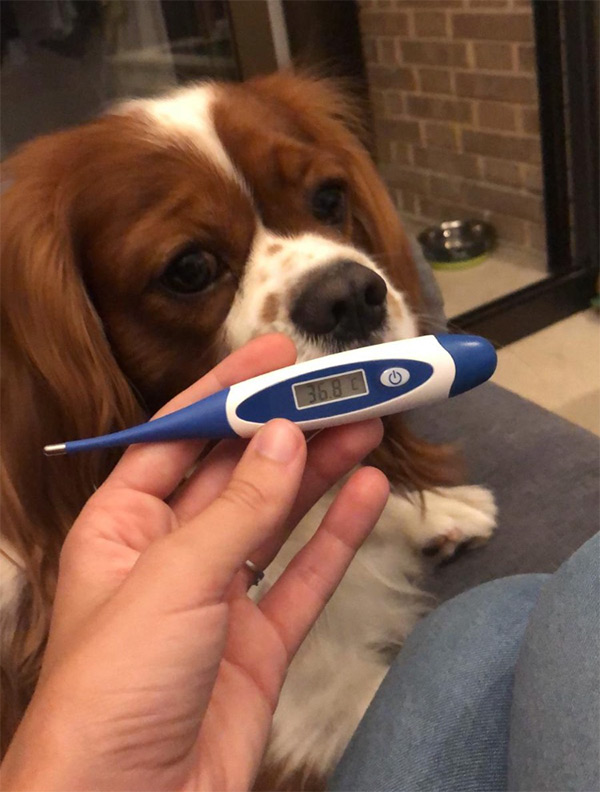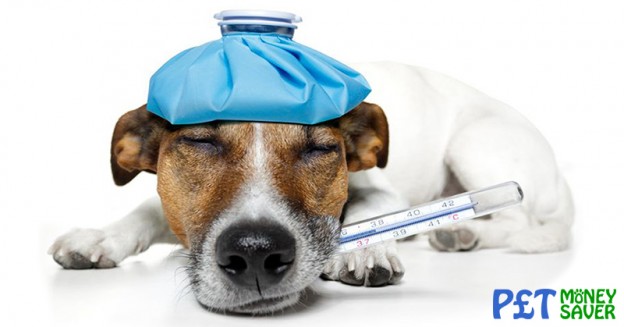and how you can bring the fever down.
We recently had an emergency trip to the vet with Rio and although all was well in the end, the process was nothing short of scary. There’s one thing knowing something is wrong with your dog, but it’s worse knowing something is wrong, but not knowing what. As our pets can’t tell us what’s wrong or where hurts, seeing them so subdued is a pet owners nightmare. Had we have known the signs and symptoms of fever, how to treat them and what might have caused it, we would have been able to treat Rio much quicker, without the lengthy uncertainty.
Instead of rushing to the emergency vet at midnight when we found blood across his bed sheets, we’d have taken him to the vet the day before and treated him at home for fever. You’re probably familiar with the idea that touching a dogs nose is a good indication for their health. They say that if the nose is hot and dry he potentially has a fever, and if it’s wet and cold, he’s fine. Although this can be true at time, it’s not one to rely on.
What is a dogs normal temperature?

I started getting quite used to knowing a dog’s normal temperature after I had started checking it once an hour after he’d been discharged from the emergency vets. A dog has a higher temperature than a human, and that range is between 38.3 degrees Celsius and 39.2 degrees Celsius (101 to 102.5 degrees Fahrenheit). A temperature of over 39.7 degrees is where it starts getting dangerous and action needs taking. You can easily check your dog’s temperature with a thermometer for pets.
What are the Signs and Symptoms
Like we said, our dogs can’t tell us when he has a fever, so it’s essential you familiarise yourself with the symptoms of fever in dogs. The most common signs of fever are as follows:
- Red eyes
- Lethargy
- Warm ears
- Warm, dry nose
- Shivering
- Lack of appetite
- Coughing
- Vomiting
What causes a fever?
For Rio, it was his impacted anal glands. Rio’s glands are such a pain and cause him such discomfort quite regularly. We hadn’t seen him scooting or scratching at his back so we thought all was well. Although regularly he needed them squeezing, it hadn’t been too long since he’d last had them expressed. The infection had caused such pain for him that the blood was the impaction of the glands. It had then led to fever. Fortunately for us all, Rio needed daily injections of antibiotics and checking each day to see if they were ready to be squeezed. He now has monthly scheduled appointments to have his glands expressed to stop the same thing happening.
But, there can be many other reasons for fever in dogs. A fever can be caused by an infection or inflammation, where their body has tried to fight it off. They can be internal or external such as:
- An infected bite, cut or scratch
- Ear infection
- Urinary tract infection
- Infected tooth
- Impacted anal glands
- Ongoing bacterial or viral diseases
- Infection of the organs
A fever can also be caused by the ingestion of poisonous toxins.
How to reduce a dog’s fever

I want to stress that if your dog has a fever it’s absolutely essential that they see a veterinarian. Fever can be fatal in dogs so if you’re sitting with a subdued dog in two minds whether to take them to a vet right now or not, do it. If you’ve took their rectal temperature or ear temperature and it’s high, this is your push to visit the vet. Although these suggestions can help bring the fever down once they’re home, it’s vital that your dog is checked over first.
First things first, never give your dog human medication. Aspirin is extremely toxic for pets so doing so will only exacerbate the problem.
To help reduce a fever, first apply some cool (not cold) water around his paws and ears. You can dampen a flannel and wrap them around the paws and the head if your dog will sit still. If not, dousing him down is fine. Continue to monitor his temperature, preferably with an anal thermometer. If you’re doing the ears or under the armpits, make sure you add a degree to the final temperature. Keep encouraging and coaxing your dog to drink plenty of water, if he won’t go to his bowl or drink out of your hands, use a syringe of 5ml to keep regularly force feeding him water.
REMEMBER TO VISIT THE VET.
This blog post is designed to give free advice and informal information about fever based on my own experience of fever and veterinary advice we were given. Just like humans, patient advice can vary so it’s essential you take your pet to the vet to have their own diagnosis. This blog is designed to give advice and not to take the place of a vet diagnosis or consultation. Ensure that you set up an appointment to see your vet if you think your dog might have a fever.
Article by Lauren Bate (diaryofaspanglishgirl.com)




